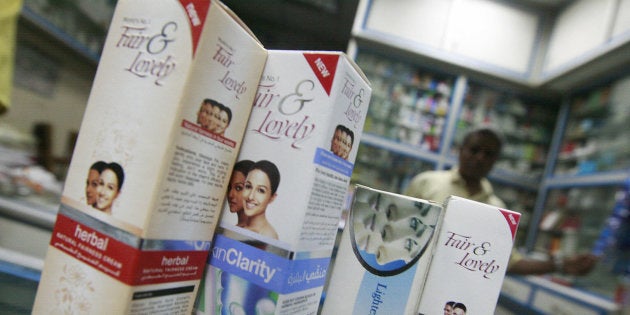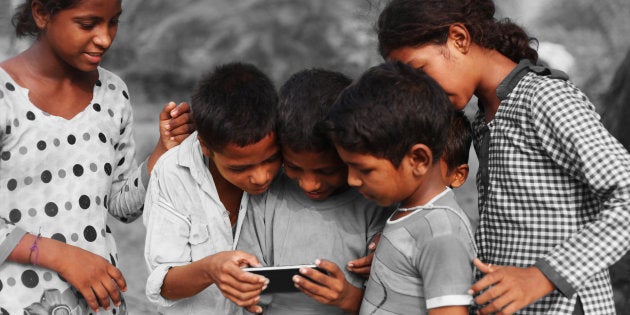When I was little, an aunt pulled me aside to give me some marriage advice. She told me to find a man so fair that when he stood next to a white wall, you wouldn't be able to see him. The incident left me shaken and confused — why would she want me to marry someone so terrifying? Later, I learned that in my South African Indian community, fair skin was perceived as a sign of high social status.
"You're lucky you're fair," friends at my Indian primary school friends would tell me. "Don't stay out in the sun or you'll spoil your colour," adults would add.
Durban has one of the largest concentrations of Indian people outside of India* so the pervasiveness of this mentality is not surprising. India has one of the largest skin whitening industries in the world — worth more than $450 million (about R6,1 billion). With a history of fair Gods and dark demons, an upper class made up of light-skinned Brahmins and a colonial history of white British power, India has transformed into a massive, colour-obsessed monster that consumes more than 233 tonnes of skin-whitening products a year.
The obsession has taken on new extremes with whitening creams produced for the underarms and nether regions. Indian skin-lightening adverts often use relationships as a hook to sell products by portraying unhappy couples whose love is reignited only when the woman achieves a lighter hue.
Local statistics are scarce but in a 2014 study conducted at the University of Kwazulu-Natal (UKZN) — which sampled 579 black women, 292 African women and 287 Indian women from Durban — 27 percent of the Indian women surveyed were using skin lighteners containing banned substances including hydroquinone, phenol and mercury.
South Africa was one of the first countries to outlaw the controversial compound, hydroquinone, and is the only country in the world to forbid advertisements for skin lighteners.
The study's principal investigator, Professor Ncoza Dlova, who is head of the dermatology department at UKZN, told HuffPost SA that she was not surprised by the findings considering the number of people presenting at healthcare facilities with skin complications.
She said abusers of skin-lightening creams present with myriad skin complications including skin infections, skin cancer, acne and ochronosis, a condition that gives people patchy dark pigmentation, often with purple or blue-black layers of skin.
"It shows that people are not comfortable in their own skin and that they believe that being fair makes them more attractive and opens up more opportunities. In certain Indian communities for instance, it is believed that the prospects for marriage are enhanced by fair skin. This perception was confirmed by our research survey," she says.
There were lots of proposals for my sisters who are light skinned but not for me. I assumed it was my skin colourAmina Peer*
Amina Peer**, a 31-year-old software developer in Durban agrees. As a young woman, she thought being fair would make her pretty. "There were lots of proposals for my sisters who are light skinned but not for me. I assumed it was my skin colour," she said. She began using skin-lightening products shortly after high school and used them for seven years until, she says, she realised she was getting darker instead of lighter.
Peer hopes that some day young people won't feel the same pressures to lighten their skins that she felt. "We need to inform and educate girls and make them feel comfortable in their own skin," she says.
After using skin lighteners herself, socialite and former Miss India South Africa Sorisha Naidoo created her own range of products, which were even endorsed by Winnie Mandela.
In 2011, Naidoo told IOL that she had become insecure about her skin colour after an FHM bikini shoot and turned to lighteners to boost her confidence.
Her product range however, later came under fire after users complained of skin damage.
A popular Indian matchmaker in Durban, who declined to be named, told HuffPost SA that colour definitely plays a role when it comes to choosing a partner in the local Indian community. "The first question I almost always receive from interested men, or their mothers, is 'Gori hai?' ('Is she white?') or 'Kali hai?' ('Is she black?')."
Men ask the question more often than women, she says. "The women rarely ask about a man's skin colour." The pressure to be fair-skinned, it seems, falls mainly on women.
Adverts on Indian marriage websites and in local newspapers like The Post are filled with men seeking wives with "fair to wheatish" complexions. But it wasn't always this way. Preference for light-skinned women is a relatively recent phenomenon among Indians globally.

In 2009, the University of Seattle's Mara Beth Adelman and Sonora Jha examined matrimonial adverts in Indian newspapers. They found that while a bride in the 1960s was idealised in terms of certain talents, like singing, the 1970s saw the emergence of sought-after attributes like education, work and physical attributes. It was only in the 1980s, they found, that physical beauty, with a particular focus on skin colour, emerged as the dominant ideal. The 1990s later ushered in the era of the "super-bride"' and, they write, "fair-skinned complexion became a form of social capital for females in attracting males".
This focus on fair skin also extends to children. Dr. Levashni Naidoo, a senior dermatologist at a popular Durban skin clinic, says she she often sees parents who have brought along their children to inquire about skin lightening. "Some of them already have severe skin damage from previous skin-lightening products," she told HuffPost SA.
Naidoo said the easy availability of skin lighteners at Indian supermarkets and community fairs is concerning as many of these products contain dangerous substances not listed on their containers. "These products are seen as cosmetic, so people don't realise there are medical side effects. These unregulated creams often contain undisclosed ingredients like steroids and, with time, can cause permanent discolouration of the skin, acne outbreaks and abnormal hair growth," she says.
She also frequently sees young brides who want treatment ahead of their weddings.
At local Indian weddings, it's traditional for brides to apply turmeric paste to their skin to tone and lighten it, and they're often encouraged to avoid the sun before the big day. They also turn to make up, using foundation shades lighter than their actual skin tone.
Once, at a photo-shoot, a Durban makeup artist asked me if I wanted to look "lighter". When I expressed confusion she said it was common for Indians to ask to look lighter on their wedding day. She often did Indian bridal make-up, she said, and was often surprised at how light some Indian brides asked to look on their wedding day. "Often it looks unnatural," she said.
Children are brought up to believe that to be attractive you have to be fair-skinned. The media further taps into the insecurities of the individual and becomes part of a larger system that promotes self-hatred, low self-esteem and self-loathing.Dr. Akashni Maharaj
Durban psychologist, Dr. Akashni Maharaj says the idea that fairness indicates superiority has been ingrained in people's minds over generations. "Children are brought up to believe that to be attractive you have to be fair-skinned. The media further taps into the insecurities of the individual and becomes part of a larger system that promotes self-hatred, low self-esteem and self-loathing. All these are psychological maladies that contribute to psychological dysfunction," she said.
The dermatologist, Naidoo, agrees, saying the obsession with skin lightening is communicated to children from a young age and then entrenched by family, peers and the media.

There's a growing drive though, to create awareness of the side-effects of skin lightening. In August 2016 Durban held its first march to highlight the dangers of skin lighteners. The march, organised by the KwaZulu-Natal department of health and UKZN invited the public to stand up for dark skin.
Dlova, who initiated the march, said it aimed to raise awareness of the dangers of skin lightening in both African and Indian communities, as 90 percent of the women surveyed in her study were unaware of the dangers and complications associated with skin lightening.
Dlova says there's an urgent need for awareness raising programmes on the dangers of skin lightening, which should include skincare education at primary schools.
"We need to educate and instil confidence in children from a young age and nip this perception in the bud, by reinforcing that the best skin colour is the one that we are born with."
* A previous version of this story stated that Durban has the highest concentration of Indians outside of India. This has been corrected.
**Not her real name
The package on colourism that Huffington Post South Africa is publishing today came from a conversation in the office as we were getting ready to launch: "Guys, we should do a video on all the ridiculous things dark-skinned women hear all the time." The choruses of "Yes!" and the stream of anecdotes – funny and awful – showed that this was an untapped well of stories waiting to be told in South Africa. We are aware that colourism exists but we're still likely to joke about "yellow bones" with the rest of our friends. Conversations about why every aspect of this culture is problematic is silenced with: "But skin lightening is a personal choice". Except that it isn't. In our series of stories we show the harmful effects of this obsession in our society – from a personal, social and economic point of view. We look at how illegal creams are still sold and how upmarket legal alternatives are still questionable. We look into small communities, like Indians in South Africa, where colourism still thrives, and talk to celebrities about why they lightened their skin. Because as a dark-skinned woman myself, I'm ready for change, and so is our society. — Verashni Pillay, Editor-in-Chief
- Skin Lightening Isn't Just A "Personal Choice", It's Highly Problematic. Here's Why.
- 24 Things You Have To Stop Saying To Dark-Skinned Women
- Let's Be Honest: Snapchat Filters Are A Little Racist
- In An Age of #BlackGirlMagic, Why Is Skin Lightening Booming ?
- The Skin-Lightening IV Drip Khanyi Mbau Uses Is Not All It's Cracked Up To Be
- Growing Up As A Dark-Skinned Girl In South Africa
- 'Toning' Is All The Rage In Nigeria, But It's Downright Alarming
